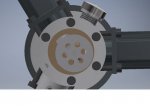This engine was desgned by Westbury to use a flash steam boiler to actually compete with the two stroke engines of the time, so anything above 80psi (and that has to be continual, so a flash steam boiler had to be used) could be used. I think it is a little like a turbine (which I have also built) where steam that isn't used just gets wasted away as I don't think that with the speed it can achieve, the steam just wouldn't have time to expand and work as efficiently as it should, like you say 'HOT'.
I did a few design mods to see if it could be easily made to reverse, but even though you could make it change direction (it was all to do with a take off from the main crank and it's position with regards to the crank centreline. I made two, one each with the offset either side, so could have it running in whatever direction I wanted but it meant a strip down each time. But having said that, either direction could be achieved, all it meant was swapping over the two steam ports. It ran slightly better in the correct direction when the correct rotation crank piece was installed.
The rotating valve at the rear, which controls the direction of the steam and exhaust HAS TO BE A PERFECT THICKNESS otherwise the entry steam can easily bleed into the exhaust line. It was a tricky job to get it to the correct thickness so very little bleed took place or you actually jammed up the rotating valve because your rotating valve got trapped because it was too thick, even a heavy hand in tightening could lock the control rotor area completely. I got mine to around two or three tenths gap and it ran very well. It took many hours of hand flatting to get the right thickness retaining parallelism of the rotor faces.
For efficiency and non loss of steam, you might have to pursue the way of poppet valves (like in a four stroke engine). I think it is that type that is normally
used with flash steam boilers. I don't think that normal slide valves could cope, whereas a poppet valve can open/close and seal instantly.
By searching on Youtube, you should find petrol fueled 4 stroke engines easily converted to steam.
BTW, my engine shown is the only engine I have ever sold (except for the ones I actually made commercially), if I remember rightly, it raised 400 pounds (about 600 bucks). All my other engines have been given away to friends and aquaintances around the world, if they showed a liking for one.
John















